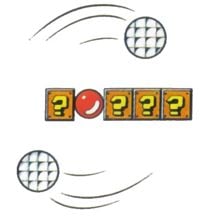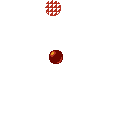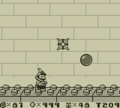| Mario & Luigi: Superstar Saga / Mario & Luigi: Superstar Saga + Bowser's Minions / Minion Quest: The Search for Bowser
|
| Characters (Superstar Saga) |
Protagonists
|
Mario1,2 • Luigi1,2 • Princess Peach1,2 • Prince Peasley • Bowser1,2
|
| Antagonists
|
Cackletta (Bowletta) • Fawful • Popple • Bowser (Rookie)1,2
|
| Supporting characters
|
Beanbean troops1,2 • Bink1,2 • Blablanadon1,2 • Bloat1,2 • Boddle1,2 • Border Bros1,2 • Bubbles • Chuckleroot1,2 • Chuckleroot's granddaughter1,2 • Cork and Cask • Dr. Toadley2 • Fava1,2 • Firebrand and Thunderhand1,2 • Hammerhead Bros.1,2 • Harhall1,2 • Hermie III • Hoohoo civilization1,2 • Jellyfish Sisters1,2 • Koopa Cruiser crew • Lady Lima1,2 • Miles Tones1,2 • Moai1,2 • Mole1,2 • Pea1,2 • Peach-bot1,2 • Pipeman1,2 • Professor E. Gadd • Prospector1,2 • Psycho Kamek1 • Queen Bean1,2 • Soybean civilization1,2 • Spangle • Starshade Bros.1,2 • Toad doctor1,2 • Toadsworth1,2 • Tolstar1,2 • Tuki1,2 • Yoshi Fan Club1,2
|
| Species
|
Ankoopa1 • Beanish1,2 • Beanlet1,2 • Big Koopa Troopa2 • Designbomb1,2 • Ghost1,2 • Hoohooligan1,2 • Kurako1,2 • Lagoon-dweller1,2 • Oho Jee • Sailor1,2 • Thwomp • Toad1,2 • Winkle1,2 • Yoshi1,2
|
| Characters (The Search for Bowser) |
Protagonists
|
Captain Goomba3 (Gold3) • Captain Shy Guy3 • Captain Boo3 (Gold3) • Captain Koopa Troopa3 (Gold3) • Koopalings (Iggy · Morton · Lemmy · Ludwig · Roy · Wendy · Larry)
|
| Antagonists
|
Cackletta (Bowletta) • Fawful • Popple
|
| Supporting characters
|
Bowser3 • Corporal Paraplonk3 • Private Goomp3 • Sergeant Guy3 • Prince Peasley • Bubbles • Cork and Cask • Hermie III • Professor E. Gadd • Spangle
|
| Special moves |
Overworld/solo attacks
|
Emergency Block2 • Counterattack1,2 • Dash1,2  • Dunk Hammer1,2 • Dunk Hammer1,2  • Firebrand1,2 • Firebrand1,2  • Flee1,2 • Hammer1,2 • High Jump1,2 • Flee1,2 • Hammer1,2 • High Jump1,2  • Jump1,2 • Mini-Mario1,2 • Jump1,2 • Mini-Mario1,2  • Pump Mario1,2 • Pump Mario1,2  • Spin Jump1,2 • Spin Jump1,2  • Surfboard1,2 • Surfboard1,2  • Tickle1,2 • Tickle1,2  • Thunderhand1,2 • Thunderhand1,2 
|
| Bros. Attacks1,2
|
Bounce Bros.  • Chopper Bros. • Chopper Bros.  • Cyclone Bros. • Cyclone Bros.  • Fire Bros. • Fire Bros.  • Knockback Bros. • Knockback Bros.  • Splash Bros. • Splash Bros.  • Swing Bros. • Swing Bros.  • Thunder Bros. • Thunder Bros. 
|
| Captain Commands3
|
Deny • Rally • Chance • Play Dead • Lightning • Parry • Pass the Bob-omb • Thwomp Thump • Clash of Captains • Call for Backup • Sneak Attack • Shell Shock
|
| Bosses |
Superstar Saga
|
Birdo • Bowletta1,2 • Bowser1,2 • Cackletta1,2 • Chuckolator1,2 • Dragohoho1,2 • Fawful • Flaret1,2 • Hermie III1,2 • Hoohooros1,2 • Jojora1,2 • Jojora's friends1,2 • Koopalings (Iggy · Morton · Lemmy · Ludwig · Roy · Wendy · Larry) • Mom Piranha1,2 • Popple • Queen Bean1,2 • Rookie1,2 • Tolstar1,2 • Trunkle1,2 • Wiggler1,2
|
| The Search for Bowser
|
Birdo • Corporal Paraplonk3 • Fawful • Koopalings (Iggy · Morton · Lemmy · Ludwig · Roy · Wendy · Larry) • Popple • Private Goomp3 • Sergeant Guy3
|
| Locations
|
Beanbean Airport1,2 • Beanbean Borderland1,2 • Beanbean Castle1,2 • Beanbean Castle Sewers/Beanbean Castle Sewer1,2 • Beanbean Castle Town1,2 • Beanbean Outskirts/Beanbean Fields • Beanbean Kingdom • Bowser's Castle • Castle Town Item Shop1,2 • Chateau de Chucklehuck1,2 • Chucklehuck Woods • Fire Palace1,2 • Guffawha Ruins1,2 • Gwarhar Lagoon • Harhall's Studio1,2 • Hoohoo Mountain • Hoohoo Village1,2 • Information Booth1,2 • Joke's End • Koopa Cruiser • Little Fungitown1,2 • Little Fungitown Item Shop1,2 • Mario and Luigi's house1,2 • Mushroom Kingdom1,2 • Oho Oasis1,2 • Oho Ocean1,2 • Pipe House1,2 • Princess Peach's Castle1,2 • Relaxation Room1,2 • S.S. Chuckola1,2 • Seabed1,2 • Starbeans Cafe1,2 • Stardust Fields1,2 • Teehee Valley • Thunder Palace1,2 • Toadtown Square/Peach's Castle1,2 • Winkle Colosseum1,2 • Woohoo Hooniversity1,2 • Yoshi Theater1,2
|
| Enemies |
Superstar Saga
|
Anuboo1,2 • Beanerang Bro • Beanie • Belly Blech1,2 • Bill Blaster1,2 • Blooper1,2 • Bob-omb • Boo • Cheep Cheep1 • Chomp Bro1,2 • Chuck Guy • Chuckorok1,2 • Clumph • Dry Bones4 • Eeker1,2 • Elite Chuck Guy • Elite Dry Bones1,2 • Elite Gritty Goomba1,2 • Elite Limbo Bro • Elite Pestnut • Elite Troopea • Fighter Fly1,2 • Fuzzbush • Fuzzy1,2 • Glurp1,2 • Gold Beanie • Goomba • Goomdiver1,2 • Gritty Goomba • Gunner Guy1,2 • Hammer Bro • Ice Snifit • Lakipea • Laser Snifit1,2 • Limbo Bro • Magikoopa • Malibut1,2 • Mecha-Blooper1,2 • Mecha-Chomp1 • Mechakoopa • Oucher Glass1,2 • Parabeanie • Paratroopea • Pestnut • Piranha Bean • Piranha Plant1,2 • Puffer-Cheep1 • Rex • Roto-Disc1,2 • Sand Cheep1,2 • Scaratroopea • Sharkbone1,2 • Sharpea • Sniper Bill1,2 • Spiky Snifit1,2 • Spiny4 • Spiny Cheep Cheep2 • Starkiss • Super Fly1,2 • Sworm1,2 • Tanoomba • Time Bob-omb1,2 • Troopea • Virus1,2 • Yo Bro1,2
|
| The Search for Bowser
|
Bandit3 • Beanerang Bro • Beanie • Big Boo3 • Big Tail Goomba3 • Bob-omb • Bomb Boo3 • Boo • Boomerang Bro3 • Broozer3 • Buzzy Beetle3 • Chain Chomp3 • Chargin' Chuck3 • Chuck Guy • Clumph • Dry Bones4 • Elite Captain Quartet3 • Elite Chuck Guy • Elite Limbo Bro • Elite Pestnut • Elite Troopea • Fire Bro3 • Fire Stalking Piranha Plant3 • Fly Guy3 • Fuzzbush • Gold Beanie • Goomba • Goomba Tower3 • Green Magikoopa3 • Gritty Goomba • Hammer Bro • Ice Bro3 • Ice Snifit • Koopa Paratroopa3 • Koopa Troopa3 • Lakipea • Lakitu3 • Limbo Bro • Magikoopa • Mechakoopa • Mechawful3 • Para-Beetle3 • Parabeanie • Paragoomba3 • Paratroopea • Pestnut • Piranha Bean • Pokey3 • Red Magikoopa3 • Rex • Scaratroopea • Sharpea • Shy Guy3 • Spear Guy3 • Spike3 • Spiny4 • Spiny Cheep Cheep2 • Starkiss • Tail Boo3 • Tanoomba • Troopea • White Magikoopa3
|
| Items |
Consumables
|
1-Up Mushroom1,2 • 1-Up Super1,2 • 100 Coin2 • 10 Coin2 • 50-Coin2 • Beanbean coin1,2 • Boo Biscuit2 • Coin1,2 • Five Coin1,2 • Golden Mushroom1,2 • Green Pepper1,2 • Max Mushroom1,2 • Max Nut1,2 • Max Syrup1,2 • Mushroom1,2 • Nut1,2 • Red Pepper1,2 • Refreshing Herb1,2 • Super Mushroom1,2 • Super Nut1,2 • Super Syrup1,2 • Syrup1,2 • Ultra Mushroom1,2 • Ultra Nut1,2 • Ultra Syrup1,2
|
| Key items
|
Bean Fruit1,2 • Beanbean Brooch1,2 • Beanbean Map1,2 • Beanstar1,2 • Beanstar piece1,2 • Beanstone1,2 • Chuckola Fruit1,2 • Chuckola Reserve1,2 • Crabbie Grass1,2 • Face1,2 • Fake Beanstar1,2 • Flaming statue1,2 • Hoohoo Spirit1,2 • Invincishroom • Membership Card1,2 • Neon Egg1,2 • Peach's Extra Dress1,2 • Pearl Bean1,2 • Peasley's Rose1,2 • Precious belonging1,2 • Red and Green Goblets1,2 • Secret Scroll 11,2 • Secret Scroll 21,2 • Suitcase1,2 • Winkle Card1,2
|
| Bean Juice1,2
|
Chuckle Blend • Chuckoccino • Hoohoo Blend • Hoolumbian • Teehee Blend • Teeheespresso • Woohoo Blend
|
| Special items
|
Bonus Ring1,2 • Cobalt Necktie1,2 • Excite Spring1,2 • Game Boy Horror SP1,2 • Great Force1,2 • Greed Wallet1,2 • Power Grip1 • Secret Specs2
|
| Blocks1,2
|
! Block • ? Block • Bros. Block • Command Block • Hidden Block • Hoohoo Block • L Block • M Block • Rally Block • Random Block • Recovery block • Save Album • Simu-Block • Spin Block
|
| Other
|
Axe1,2 • Badge1,2 • Bean1,2 • Bike Pads1,2 • Black Rock1,2 • Boo Statue1,2 • Brown Rock1,2 • Button1,2 • Cart1,2 • Gold ring • Chuckola Cola1,2 • Clothing1,2 • Conductor1,2 • Gown1,2 • Gray Rock1,2 • Headgear1,2 • Invincibility Mushroom3 • Koopa Clown Car1,2 • Lift1,2 • Poison Mushroom1,2 • Poltergust 30001,2 • Pressure Plate1,2 • Region map1 • Rolling Bar Defense System1,2 • Spiky Stardust Defense System1,2 • Spring Pad1,2 • Super Poltergust 30011,2 • Surfing Spot1,2 • Toad Express1,2 • Torch1,2 • Wall Face1,2 • Warp Pipe1,2 • Watering hole1,2 • Waterspout1,2
|
| Minigames1,2
|
Border Jump • Mysterious Mine Carts • Star 'Stache Smash • Barrel • Chuckola Bounce • Surfing Game • Splart
|
| Stats
|
Bros. Point1,2 • Defense • Experience Point • Heart Point • Level up • Power • Speed1,2 • Spirit3 • Stache1,2
|
| Status
|
Burn1,2 • Charred1,2 • DEF-Down • DEF-Up • Dizzy • Fury2 • Heavy G1,2 • Invisible2 • Light G1,2 • Poison1,2 • POW-Down • POW-Up • Prohibited Command1,2 • SPD-Down1,2 • SPD-Up1,2 • Trip1,2
|
| Other
|
Bean Fever1,2 • Beanbean Air • Beanhole locations1 (Bowser's Minions2) • Block locations1,2 • Bestiary1 (Bowser's Minions2) • Enemy formations1,2 • Gallery1 (Bowser's Minions2) • Gear1 (Bowser's Minions2) • Glitches1 (Bowser's Minions2) • Hidden Block locations1 (Bowser's Minions2) • Hooroglyphs1,2 • In-game music2 • Kingdom Courier1,2 • Level up progressions1,2 • Mario & Luigi RPG: Sound Selection1 • Mario Bros.1 • Pre-release and unused content1 • Quotes1 (Bowser's Minions2) • Shops2 • Special Skill3 • Staff1 (Bowser's Minions2) • Story summaries2 • Super Attack1,2
|
|
|





